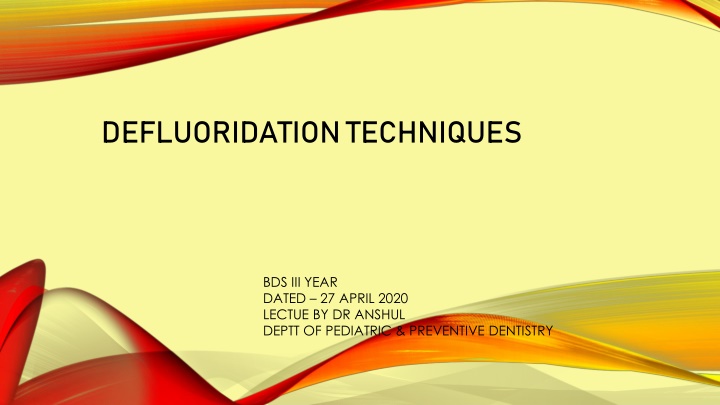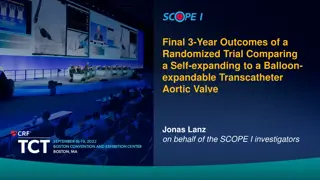
Effective Defluoridation Techniques in Dentistry
Learn about the importance of defluoridation techniques in preventing dental fluorosis and achieving optimal fluoride concentration in drinking water. Explore various methods such as adsorption, ion-exchange, precipitation, and other innovative techniques to remove excess fluoride. Discover the materials used in adsorption techniques and the regions in India endemic for fluorosis. Stay informed on current standards and permissible limits for fluoride in drinking water.
Download Presentation

Please find below an Image/Link to download the presentation.
The content on the website is provided AS IS for your information and personal use only. It may not be sold, licensed, or shared on other websites without obtaining consent from the author. If you encounter any issues during the download, it is possible that the publisher has removed the file from their server.
You are allowed to download the files provided on this website for personal or commercial use, subject to the condition that they are used lawfully. All files are the property of their respective owners.
The content on the website is provided AS IS for your information and personal use only. It may not be sold, licensed, or shared on other websites without obtaining consent from the author.
E N D
Presentation Transcript
DEFLUORIDATIONTECHNIQUES BDS III YEAR DATED 27 APRIL 2020 LECTUE BY DR ANSHUL DEPTT OF PEDIATRIC & PREVENTIVE DENTISTRY
Fluoride is often described as a double-edged sword as inadequate ingestion is associated with dental caries, where as excessive intake leads to dental, skeletal and soft tissue fluorosis- Water is essentaiL element for life and may be contaminated by natural sources or insdustrial wastage . One such contaminant is fluoride. Fluoride is a normal constituents of natural water and its concentraton varies depending on the water source. WHO standards and Bis permits only 1.5 mg/dl as the upper permissible limit for fluoride in drinking water in indian context Permissible limit of fluoride in drinking water prescribed by various organizations Permissible limit of fluoride ion (mg/l) S. No. Name of organization World Health Organization (International standard of drinking water) ICMR ICMR: Indian Council of Medical Research, BIS BIS: Bureau of Indian Standards 1. 0.6-1.5 2. 1.0 3. 0.6-1.5
Presently 17 states which are endemic for fluorosis are- 40-100% districts in Andhra Pradesh, Gujrat, Rajasthan 40-70% districts in Bihar , Delhi, Haryana Jharkhand , Maharastra , MP, Orissa, Tamilnadu , UP 10-40% in Assam , J& k, kerala , Chattisgarh ,West Bengal Providing water, with optimal fluoride concentration can be achieved by the following methods: Removal of fluoride from water (defluoridation), using suitable techniques. Locating alternative sources of safe water. Bringing in water from a distant, safe source. Prevention of industrial fluorosis by rigorous enforcement of procedures for minimizing industrial fluoride pollution.
DEFLUORIDATION Downward adjustment of concentration of fluoride ion in the public water supply in such a way that the concentration of fluoride In water is maintained constantly at 1ppm. DEFLUORIDATION DEFLUORIDATION TECHNIQUES CAN BE BROADLY CLASSIFIED IN TO FOUR CATEGORIES: TECHNIQUES CAN BE BROADLY CLASSIFIED IN TO FOUR CATEGORIES: 1. ADSORPTION TECHNIQUE 2. ION-EXCHANGE TECHNIQUE 3. PRECIPITATION TECHNIQUE 4. OTHER TECHNIQUES, WHICH INCLUDE ELECTRO CHEMICAL ,REVERSE OSMOSIS .
Adsorption Technique This technique functions on the adsorption of fluoride ions onto the surface of an active agent. MATERIALS USED Activated alumina, activated carbon and bone char were among the highly tested adsorbing agents. 1> Carbon materials, Activated Alumina, Magnesia, Tricalcium phosphate, Calcite, Hydroxy apatite, Wood, Lignite, Activated char coal, Fish bone char, Processed bone, Fly ash, Bauxite, Serpentine 2> Natural adsorbants- Nut shells, Avaram bark, Paddy husk, Coffee husk, Tea waste, Jute waste, Coir pitch, Seeds of the Drumstick tree, roots of Vetiver grass and Tamarind seeds
Most Commonly Used Adsorbents Are Activated Alumina And Activated Carbon. Activated Alumina ( Prasanti technology ) Application Of Domestic Defluoridation Plant, Based On Activated Alumina, Was Launched By UNICEF In Rural India The Disadvantages With Activated Alumina Are; Adsorption Of Fluoride Is Possible Only At Specific Ph Range, Needing Pre And Post- Ph Adjustment Of Water. Frequent Activation Of Alumina Is Needed, Which Make The Technique Expensive. Bone Char The Process Of Defluoridation By Bone Char As The Ion Exchange And Adsorption Between Fluoride In The Solution. The Efficacy Of The Plant Depends Upon Temperature And Ph Of Raw Water; Duration For Which The Bone-char Is In Contact With Raw Water. It Is A Highly Economic Technique With A Defluoridation Percentage Of 62 To 66 Disadvantage : The Bone Char Harbors Bacteria And Hence Unhygienic. It Is A Technique Sensitive Procedure, The Use Of Bone-char May Invite Cultural And Religious Objections
Brick pieces column The basic principle of functioning of Brick piece column is the same as that of activated alumina. The soil used for brick manufacturing contains Aluminium oxide. During burning operation in the kiln, it gets activated and adsorbs excess fluoride when raw water is passed through Replacement of filter media is required once in three months if fluoride content in raw water is 2.50 mg/l Mud pot mud pot also will act as an adsorbent media. The fluoride removal capacity will vary with respect to the alumina content present in the soils used for pot production The major advantages of mud pots are they are economic and readily acceptable for the rural communities .
Ion-exchange technique THESE RESINS HAVE BEEN USED IN CHLORIDE AND HYDROXY FORM. THE FLUORIDE EXCHANGE CAPACITY OF THESE RESINS DEPENDS UPON THE RATIO OF FLUORIDE TO TOTAL ANIONS IN WATER
ADSORPTION THROUGH ION EXCHANGE 1. process involves passage of water through a contact bed where fluoride is removed by ion exchange or surface chemical reaction with solid bed matrix. 2. water is filtered down through column packed with an ion exchange resin. 3. when adsorbent becomes saturated with fluoride ions (f-), material must be backwashed (recharged) with a mild acid or alkali solution to clear and regenerate it Disadvantages : The resins increased the concentration of chloride in treated water, which can cause corrosion of the water storage utensils. The treated water also had high pH. regeneration process of cation and anion exchange resins required large volumes of regenerant. the resins are very complex, contamination prone and expensive waste produced is also very large
Defluoron 1:- - Bhakuni (1964) Sulphonated Saw Dust Impregnate With 2% Alum Solution Drawbacks :- The Medium Had Poor Hydraulic Properties Suffered From Heavy Attritional Losses Cost Defluoron 2:- Developed in 1968 Sulphonated Coal and works on Aluminum cycles life of medium 2-4 yrs The average fluoride removal capacity of the medium was 484 mgF/L Disadvantages For regeneration and maintenance there is a requirement for skilled operator
Precipitation technique The drawbacks of Ion-exchange and adsorption techniques are: The necessary flow through system is often difficult to arrange where there is no piped water supply gradual exhaustion of the active agent is not easily detected. Precipitation Materials Precipitation methods are based on the addition of chemicals (coagulants and coagulant aids) and the subsequent precipitation of a sparingly soluble fluoride salt as insoluble fluorapatite Fluoride removal is accomplished with separation Lime & Alum (Nalgonda technique), Alum flock blanket method, Poly Aluminium Chloride (PAC), Poly Aluminium Hydroxy Sulphate (PAHS), Brushite of solids from liquid .
Precipitation technique - NalgondaTechnique National Environmental Engineering Research Institute (NEERI), Nagpur has evolved an economical and simple method for removal of fluoride which is referred to as Nalgonda Technique (Nawlakhe et al 1974). The process comprises addition in sequence of sodium aluminate (filter alum), lime and bleaching powder to the fluoride water followed by flocculation, sedimentation , filtration and disinfection This technique is extremely useful for both domestic as well as for community water supply. 1. Aluminium salts (aluminium sulfate-alum or aluminium chloride or combination of these two) : responsible for removal of fluoride from water 2. Lime : facilitates forming dense flocks for rapid settling of insoluble fluoride salts . Dose : empirically 1/20th of that of the dose of aluminium salt 3. Bleaching powder : disinfection-3 mg/l
Mechanism of Nalgonda technique 2>>>> Flocculation:- It is the 2nd stage of the formation of suitable particles(flocs) from destabilized colloidal size particles. 1>>>> Rapid mix:- provides thorough mixing of chemicals The unit holds 22 litres of water, which is filled into the upper chamber. Rapid mixing is an operation by which the coagulant is rapidly and uniformly dispersed through out a single or multiple phase system It is rapidly mixed for a period of 30 to 60 sec with speed of 10 to 20 rpm so that the coagulant is rapidly and uniformly dispersed. It is achieved by gentle and prolonged mixing for a period of 10 to 15 min with the speed of 2 to 4 rpm. combination of poly hydroxy aluminum complex with fluoride & polymeric aluminum hydroxides are formed (flocs) turbidity, color ,odour removed; bacterial load reduces This help in the formation of micro flocs and result in proper utilization of chemical coagulant. Lime ensures that residual aluminum does not remain in treated water
4>>>> Filtration: It is the process of separating suspended and colloidal impurities from water by passes through a porous media. 3>>>> Sedimentation : It is the separation from the water by gravitational setting of suspended particles that are heavier than water. The flocculated water is allowed to settle and filter through fullers earth candle overnight. Factors that affect sedimentation are: a) Size,shape,density and nature of particles b) Viscosity,density and temperature of water. c) Surface over flow rate. d) Velocity of flow. e) Effective depth of settling zone. 5>>>> Disinfection :- rechlorinated with bleaching powder before distribution Treated water will be available for drinking and cooking with desire level of fluoride
Domestic Defluoridation carried out in a container( bucket) 40lts capacity with tap 3-5 cm above the bottom the raw water in the container is mixed with adequate amount of aluminum sulphate (alum), lime, & bleaching powder depending upon its alkalinity & fluoride content alum solution is added first & mixed well with water lime and bleaching powder is then added & stirred slowly for 20min allowed to settle for nearly one hour the supernatant water , which contains permissible amount of fluoride is withdrawn thro the tap for consumption
When to adopt Nalgonda technique? The Nalgonda Technique Is Normally Adopted When The Area Under Consideration Has Following Characteristic Features: Absence Of Acceptable, Alternate Low Fluoride Source Within Transportable Distance. Total Dissolved Solids Below 1500 Mg/L Total Hardness Is Below 600 Mg/L. Alkalinity Of The Water To Be Treated Must Be Sufficient To Ensure Complete Hydrolysis Of Alum Added Raw Water Fluorides Ranging From 1.5 - 20 Mgf/L
Advantages > Regeneration of media is not required. > No handling of caustic acids and alkalies. > The chemicals required are readily available and are used in conventional municipal water treatment. > Adaptable to domestic use. > Economical > Can be used to treat water in large quantities for community usage. > Simplicity of design, construction, operation and maintenance. > Highly efficient removal of fluorides from high levels to desirable levels. Disadvantages > Desalination may be necessary when the total dissolved solids exceed 1500 mg/l. Hardness of the raw water in the range of 200 mg/l to 600 mg/l requires precipitation softening and beyond 600 mg/l becomes a cause for rejection or adoption of desalination. > Generation of higher quantity of sludge compared to electrochemical defluoridation > The large amount of alum needed to remove fluoride. > Careful pH control of treated water is required. > Simultaneous removal of color, odor, turbidity, bacteria and organic contaminants. > Normally, associated alkalinity ensures fluoride removal efficienc > Little wastage of water and least disposal problems. > Needs minimum of mechanical and electrical equipment. > No energy, except muscle power is required for domestic equipment. > Provides de-fluoridated water of uniform acceptable quality.
MODIFICATIONS FOR NALGONDA TECHNIQUE. POLY ALUMINIUM CHLORIDE It Is Evident That For Higher Concentrations Of Fluoride, The Removal Efficiency Of Fluoride Is Higher With Poly Aluminium Chloride (PAC) When Compared With Alum. However, Since Alum Is More Affordable And Accessible POLY ALUMINIUM HYDROXY SULPHATE(PAHS) A Polymeric Aluminum Compound, Poly-aluminium-hydroxy-sulphate(pahs) is found to require less flocculation time and settling time.detention time of 20 to 30 minutes will suffice for complete settlement of all flocks. Cost of pahs is much less than the alum.
Miscellaneous methods Reverse osmosis, the hydraulic pressure is exerted on one side of the semi permeable membrane which forces the water across the membrane leaving the salts behind. Electrolysis. The basic principle of the process is the adsorption of fluoride with freshly precipitated aluminum hydroxide, which is generated by the anodic dissolution of aluminum or its alloys in an electro chemical cell. The relative size of the pollutants left behind depends on the pressure exerted on the membrane. The removal of fluoride in the reverse osmosis process has been reported to vary from 45-90% as the pH of the water is raised from 5.5-7. Electro dialysis, the membranes allow the ions to pass but not the water. the driving force is an electric current which carries the ions through the membranes
as compared several advantages with other treatment methods certain disadvantages that limit their usage >The membranes are very sensitive to pH and temperature > the process is highly effective for fluoride removal. > no addition of chemicals > it removes all the ions present in water. since though some minerals are essential for proper growth therefore, remineralisation is required after treatment > the process permits the treatment and disinfection of water in one step > it ensures constant water quality > very little maintenance is needed > life of membrane is sufficiently long so problem of regeneration or replacement is encountered less frequently > the process is expensive in comparison to other options > the water becomes acidic and needs ph corrections > lots of water gets wasted as brine disposal of brine is a problem. > it works under wide ph range
DONNAN DIALYSIS (DD) DD is also based on membrane filtration that utilizes counter diffusion of two or more ions through an ion- exchange membrane to achieve a separation. DD is highly efficient in treating fluoride contaminated water and used for the treatment of low-concentration waters . Limitations 1. Expensive 2. Reduced efficiency in saline waters. NANOFILTRATION Nanofiltration is a process which takes in the upper end of RO, and the lower end of ultrafiltration. Permeability of Nanofiltration membranes is higher than those of RO. Nanofiltration membranes have a high retention of charged particles. It requires less pressure and capital than RO and it is widely applicable especially for drinking and waste water treatment .


